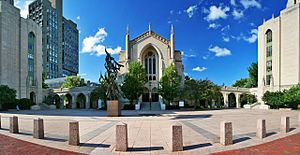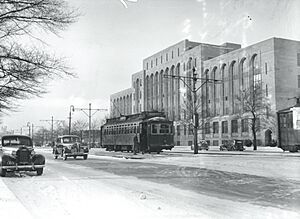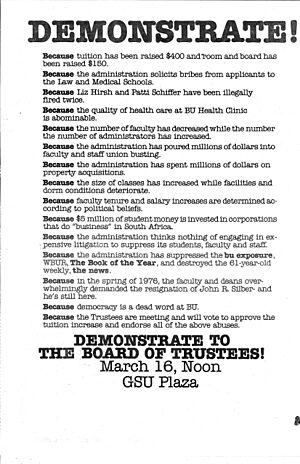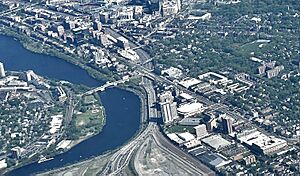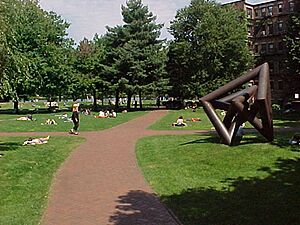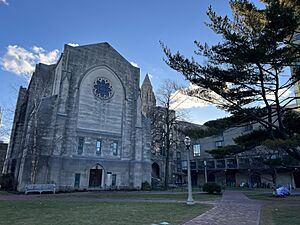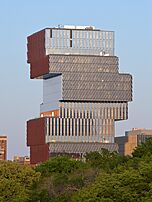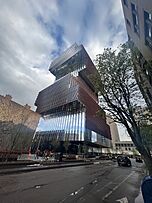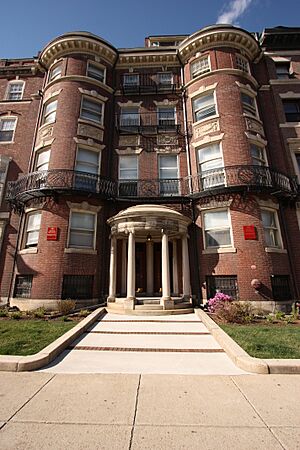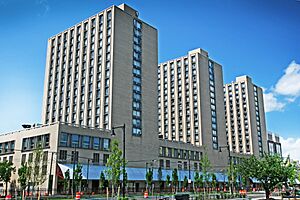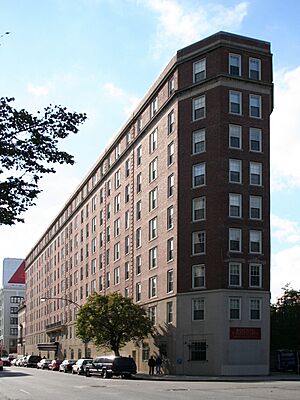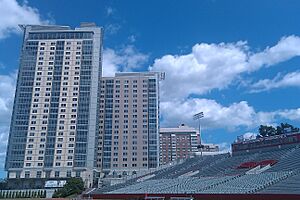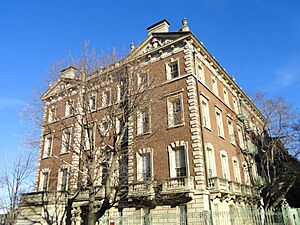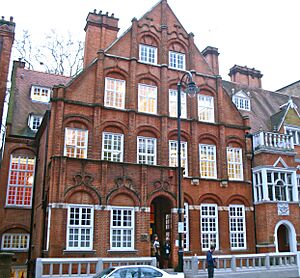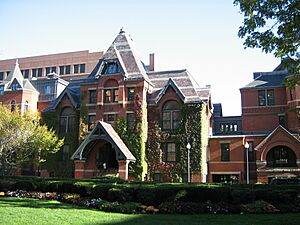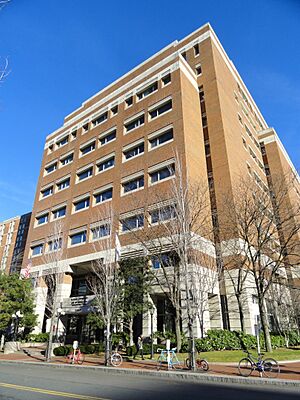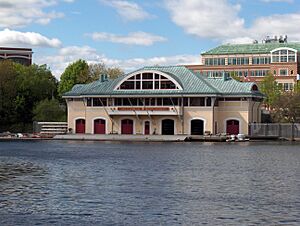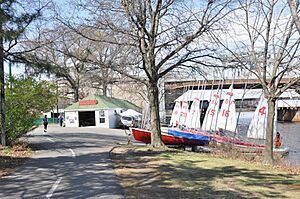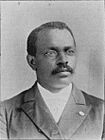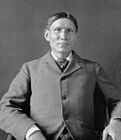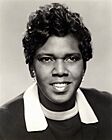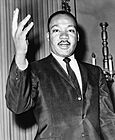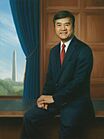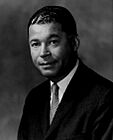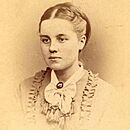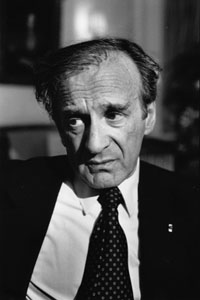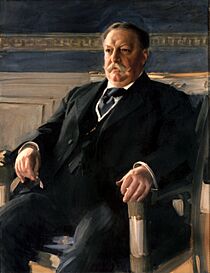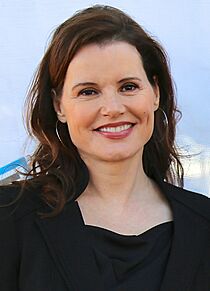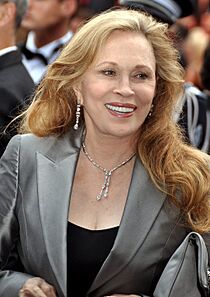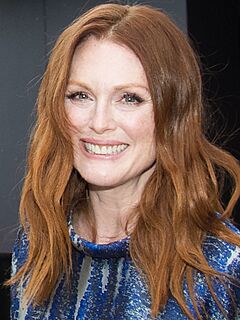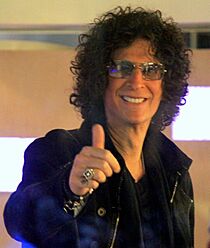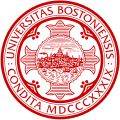Boston University facts for kids
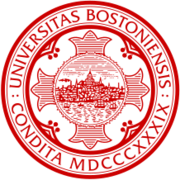 |
|
| Latin: Universitas Bostoniensis | |
|
Former name
|
Newbury Biblical Institute (1838–1847) Methodist General Biblical Institute (1847–1867) Boston Theological Seminary (1867–1869) Boston Theological Institute (1869–1871) |
|---|---|
| Motto | "Learning, Virtue, Piety" |
| Type | Private research university |
| Established | April 24, 1839 |
| Accreditation | NECHE |
|
Religious affiliation
|
Nonsectarian, but historically affiliated with the United Methodist Church |
|
Academic affiliations
|
|
| Endowment | $3.5 billion (2024) |
| President | Melissa L. Gilliam |
| Provost | Gloria S. Waters |
|
Academic staff
|
4,490 (2024) |
|
Administrative staff
|
11,414 (2024) (including faculty) |
| Students | 37,367 (2024) |
| Undergraduates | 17,926 (2024) |
| Postgraduates | 18,074 (2024) |
|
Other students
|
1,367 (2024) |
| Location |
,
,
United States
42°20′56″N 71°06′01″W / 42.34889°N 71.10028°W |
| Campus | Large city, 169 acres (0.68 km2) |
| Other campuses | |
| Newspaper | The Daily Free Press |
| Colors | Red and white |
| Nickname | Terriers |
|
Sporting affiliations
|
|
| Mascot | Rhett the Boston Terrier |
 |
|
Boston University (BU) is a private research university in Boston, Massachusetts, United States. It was started in 1839 by a group of Methodists in Newbury, Vermont. The university officially became "Boston University" in Boston in 1869.
BU is a member of the Association of American Universities. This group includes many top research universities. The university has almost 38,000 students and over 4,000 teachers. It is one of the biggest employers in Boston.
BU offers many types of degrees, from bachelor's to doctorates. These are taught through 17 different schools and colleges. The university has three main campuses in Boston. Its sports teams are called the Terriers. They compete in NCAA Division I and their mascot is Rhett the Boston Terrier.
Even though it started with a religious connection, BU is now open to people of all beliefs. The main campus is along the Charles River in Boston. The medical campus is in the South End neighborhood. BU is known for its high level of research activity. Many famous people have been connected to BU, including Nobel Prize winners and Pulitzer Prize winners.
University History
How Boston University Started
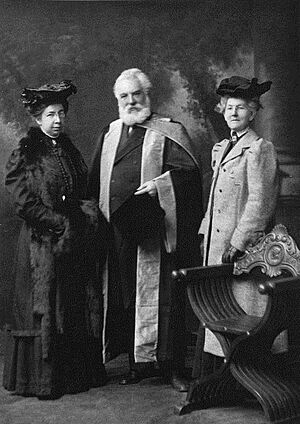
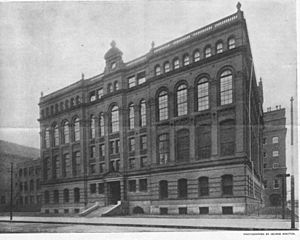
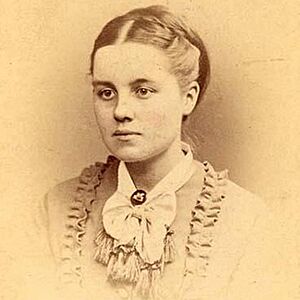
Boston University began as the Newbury Biblical Institute in Newbury, Vermont, in 1839. In 1869, the Massachusetts Legislature officially gave it the name "Boston University."
In 1839, a group of Methodist ministers decided to create a Methodist school for religious studies. This school was set up in Newbury, Vermont. In 1847, the school moved to Concord, New Hampshire. It was then called the "Methodist General Biblical Institute."
After 20 years, the school's leaders bought land in Brookline, Massachusetts. In 1867, it moved to Boston and became the "Boston Theological Seminary."
In 1869, three important Boston businessmen and Methodists helped get a new charter for a university named "Boston University." These founders were Isaac Rich, Lee Claflin, and Jacob Sleeper. Their names are now on three dorms at BU. Lee Claflin's son, William, was the Governor of Massachusetts and signed the university's charter.
The founders made sure the university's charter included an important rule. It said that teachers and students could not be turned away because of their religious beliefs. This rule did not apply to the theology department. This meant that all parts of the new university were open to everyone, no matter their gender, race, or religion (except for the School of Theology).
The Boston Theological Institute became part of Boston University in 1871. It is now known as the BU School of Theology.
In 1872, Isaac Rich passed away. He left most of his money and property to Boston University. This was a very large gift for a university at that time. However, a big fire in Boston later that year destroyed many of the buildings he left. This greatly reduced the value of his gift. Because of this, the university could not build its planned campus.
In 1875, Alexander Graham Bell, a professor at BU, invented the telephone in a university lab. In 1877, Helen Magill White became the first woman in the U.S. to earn a PhD from an American university at BU. In 1878, Anna Oliver was the first woman to get a theology degree in the U.S. Lelia J. Robinson, a law school graduate in 1881, was the first woman allowed to practice law in Massachusetts. Solomon Carter Fuller, a medical school graduate in 1897, became the first Black psychiatrist in the U.S. He made important discoveries about Alzheimer's disease.
The 20th Century at BU
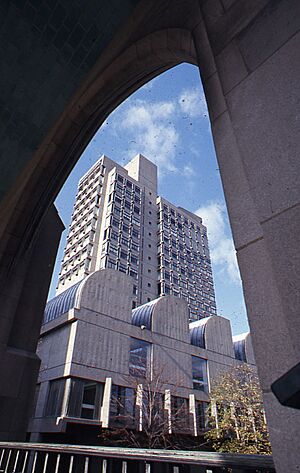
In the 1920s, BU bought land along the Charles River to create a central campus. This land was later affected by the building of Storrow Drive. Despite challenges like the Great Depression and World War II, the university slowly built its new campus. By 1936, over 10,000 students attended BU.
In 1951, Harold C. Case became president. Under his leadership, the campus grew a lot. It tripled in size and added many new buildings. Large dorms like Claflin, Rich, and Sleeper Halls were built. Later, Warren Towers, a very large dorm, was constructed. Many buildings from the 1960s, like the BU Law Tower and Mugar Memorial Library, were built in a modern style.
During the 1960s, there were student protests at BU. President Case faced challenges from students who wanted more say in university decisions.
The presidency of John Silber also saw much growth. He wanted to make BU a global research center. He brought in famous teachers, including Nobel Prize winners like Elie Wiesel and Derek Walcott. Silber also expanded the campus by building new centers for science and business. Campus growth continued into the 2000s with new dorms and the Agganis Arena.
Student Protests and Activism
In 1968, African-American students held a sit-in to protest the university's curriculum. They presented ten demands, and nine were approved. These included creating a Martin Luther King Chair and expanding resources for African-American students.
In the 1970s, students protested against military recruitment on campus. In 1972, police were called to a protest, and some students were arrested. President Silber supported military recruitment to help the university get federal grants.
In 1978, about 900 students protested a tuition increase. They marched into a meeting of the university's leaders, causing a disruption. Some students were arrested.
In 1979, many faculty members and staff went on strike. They were seeking better contracts and union recognition. The strike ended with good results for the employees.
Boston University in the 21st Century
In 2012, Boston University was invited to join the Association of American Universities. This group includes 66 top research universities in the U.S. and Canada.
That same year, BU started a big fundraising campaign to raise $1 billion. This money was for student financial aid, supporting teachers, research, and improving buildings. The campaign was very successful, raising $1.85 billion by 2019.
Since 2006, the Charles River and Medical Campuses have added many new buildings. These include new student residences, sports fields, and academic centers. In 2017, a large donation of $115 million from Rajen Kilachand helped build the Rajen Kilachand Center for Integrated Life Sciences & Engineering.
In 2019, BU improved its financial aid program. It now helps all U.S. students who qualify for financial aid by meeting their full financial need.
In 2023, Melissa Gilliam was named the new president. She started her term on July 1, 2024.
BU's Response to the COVID-19 Pandemic
In March 2020, the university closed due to the COVID-19 pandemic. Classes moved online for the rest of the semester. For the fall 2020 semester, BU offered a mix of online and in-person classes. The university also started its own COVID-19 testing lab. This lab could process thousands of tests daily, giving results quickly. A team also worked on contact tracing to help stop infections.
BU's National Emerging Infectious Diseases Laboratories (NEIDL) worked with live coronavirus samples. In 2021, BU required all students, faculty, and staff to be vaccinated against COVID-19.
University Campus
Boston Campuses and Buildings

Boston University's main Charles River Campus stretches along Commonwealth Avenue. It follows the Green Line subway for over a mile. The Boston University Bridge separates the Main Campus from the West Campus. West Campus has sports facilities and dorms. BU also has a campus in the Fenway area for undergraduate students.
A grassy area between BU buildings and Storrow Drive is called "BU Beach." Students use it to relax. Pedestrian bridges help students cross Storrow Drive safely.
BU's campus has many different types of buildings. Some, like the College of Arts and Sciences and Marsh Chapel, are in a traditional "collegiate gothic" style. Many buildings, especially along Bay State Road, are traditional Boston brownstone townhouses.
More modern buildings were added from the 1960s to the 1980s. These include the Mugar Library and Warren Towers. Newer buildings like the Center for Computing & Data Sciences and the Photonics Center use brick and glass.
In 2018, Boston University bought the former Wheelock College. This area is now called the Boston University Fenway Campus.
In 2021, BU finished a big renovation of the Henry M. Goldman School of Dental Medicine. This project added more clinical spaces and learning areas.
The Center for Computing and Data Sciences opened in 2022. It is known for being Boston's largest carbon-neutral building and for its unique design.
Student Living Spaces
Boston University has one of the largest housing systems for four-year colleges in the U.S. BU guarantees on-campus housing for all undergraduate students for four years. About 76% of undergraduate students live on campus. Students living in dorms must have a meal plan.
BU's housing includes old 19th-century brownstone townhouses and large high-rise buildings. The big dorms include the 1,800-student Warren Towers, West Campus, and The Towers. Smaller dorms are mostly on Bay State Road and in the South Campus area.
The newest student living area is called 33 Harry Agganis Way, also known as "StuVi2." It is part of The John Hancock Student Village project. This building has apartment-style and dormitory-style suites.
BU also has specialty houses for students with specific interests. Kilachand Hall, formerly Shelton Hall, is rumored to be haunted by the ghost of playwright Eugene O'Neill.
John Hancock Student Village
The Student Village is a large new area for living and recreation. It covers about 10 acres. The first dorm building, 10 Buick Street, opened in 2000. In 2002, John Hancock Insurance sponsored the project.
The Agganis Arena, named after Harry Agganis, opened in 2005. It hosts hockey games and concerts. It can hold over 6,000 people for Terrier hockey games. The Fitness and Recreation (FitRec) Center also opened in 2005. More residential towers were finished in 2009.
Other University Facilities
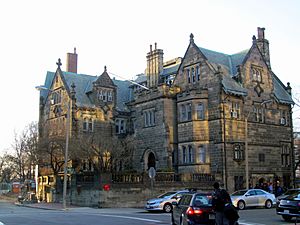
The Mugar Memorial Library is the main library for the Charles River Campus. It holds many important documents and collections.
The George Sherman Union (GSU) is a student center. It has a food court with many fast-food options. It also has lounge areas for students to relax or study. The GSU basement has a lounge called BU Central, which hosts concerts.
BU Castle, built in 1915, is one of the older buildings on campus. It used to be the university president's home. Now, it is used for conferences. The BU Pub, the only BU-operated place to buy drinks on campus, is located underneath the Castle.
The Florence and Chafetz Hillel House is a center for the university's Jewish community. It has lounges, study rooms, and a kosher dining hall. It also hosts many student groups and events.
Cultural Life at BU
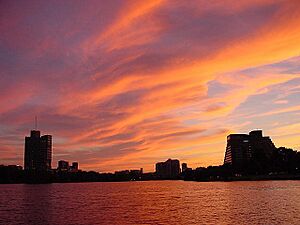
BU is located near areas with many cultural attractions. The Fenway-Kenmore area has the Museum of Fine Arts and Fenway Park, home of the Boston Red Sox. Allston is known for its artists, musicians, and small music venues.
Nearby Brookline offers independent films and author readings. Other cultural places include Symphony Hall and the main branch of the Boston Public Library. Across the Charles River, Cambridge has museums, shops, and galleries.
BU is home to the Boston Playwrights' Theatre. The university also hosts musical performances at the Tsai Performance Center and the CFA Concert Hall. Student and visiting artist works are shown in the university's three art galleries.
Guest Policies
Since 2007, Boston University has allowed students to visit other dorms easily. Students can use their ID cards to enter any on-campus dorm during certain hours. They can also sign in guests with a photo ID at any time.
Public Transportation
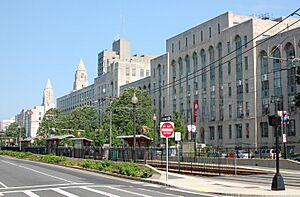
Most of BU's main campus buildings are on or near Commonwealth Avenue. This area is served by the Green Line subway. The South Campus and Fenway Campus are served by other Green Line branches. MBTA bus routes also run near the campus.
Bicycle traffic is common on Commonwealth Avenue. There are plans to improve safety for cyclists and pedestrians. The MBTA also plans to make subway stops more accessible and faster.
The medical campus is served by several bus routes and the Silver Line. The nearest subway station is the Massachusetts Avenue station on the Orange Line.
Sustainability Efforts
Boston University has a special office and plan for sustainability. The university wants to be carbon neutral by 2040. To help with this, BU bought a wind farm in South Dakota.
In 2022, the Boston University Institute for Global Sustainability was created. This institute does research on sustainability, focusing on fairness and equality.
Other University Campuses
London Campus
Boston University has a large study abroad program in London, England. Students can study and work in London through the London Internship Program. This program combines an internship with classes about British history and culture. Students earn Boston University credits. The London campus is in South Kensington, London, and has academic buildings and student residences.
Los Angeles Campus
In Los Angeles, BU has an internship program for students interested in film, television, advertising, and entertainment. Students can choose from different areas like Film and Television or Entertainment Management. They take classes and work as interns in the industry.
Paris Campus
The Paris Center offers several programs. The Paris Internship Program allows students to take language classes and intern with French businesses. Students live with host families or in a dorm. BU Paris also has exchange programs with other universities in Paris.
Washington, D.C. Campus
In Washington, D.C., Boston University offers internship and journalism programs. Students study in a BU building on Massachusetts Avenue. They can intern at news outlets, government offices, and other organizations. A new residence building houses students in the program.
Sydney Campus
In Sydney, Australia, Boston University has programs for internships, management, and other fields. Students live in a BU building in Chippendale. The building has classrooms, offices, a library, and a roof patio.
Academics at BU
Schools and Colleges
| College/School | Year founded |
| School of Theology | 1839 |
| Chobanian & Avedisian School of Medicine | 1848 |
| School of Law | 1872 |
| College of Arts & Sciences | 1873 |
| Graduate School of Arts & Sciences | 1874 |
| Sargent College of Health and Rehabilitation Sciences (Sargent College) | 1881 |
| Questrom School of Business | 1913 |
| Wheelock College of Education & Human Development | 1918 |
| School of Social Work | 1940 |
| College of Communication | 1947 |
| College of Engineering | 1950 |
| College of General Studies | 1952 |
| College of Fine Arts | 1954 |
| Henry M. Goldman School of Dental Medicine | 1963 |
| Metropolitan College | 1965 |
| School of Public Health | 1976 |
| School of Hospitality Administration | 1981 |
| Arvind & Chandan Nandlal Kilachand Honors College | 2010 |
| Frederick S. Pardee School of Global Studies | 2014 |
Boston University has 17 schools and colleges that offer many different degrees. The newest school is the Frederick S. Pardee School of Global Studies, started in 2014. In 2018, the Boston University Wheelock College of Education & Human Development was renamed after merging with Wheelock College.
In 2019, BU created the Faculty of Computing & Data Sciences. This group helps students learn about computing and data science. In 2022, BU's medical school was renamed the Aram V. Chobanian & Edward Avedisian School of Medicine.
Each school and college at BU has a short, three-letter name. For example, the College of Arts & Sciences is called CAS.
BU's Mental Health Counseling and Behavioral Medicine Program offers a master's degree. This program trains students to become licensed mental health counselors. It is the only program of its kind in a medical school in the U.S. Boston University is officially recognized by the New England Commission of Higher Education.
Student Admissions
Fall Freshman statistics
| 2024 | 2023 | 2022 | 2021 | 2020 | 2019 | |
|---|---|---|---|---|---|---|
| Applicants | 78,769 | 80,495 | 80,794 | 75,733 | 61,006 | 62,210 |
| Admits | 8,743 | 8,733 | 11,434 | 13,884 | 11,286 | 11,260 |
| Admit Rate (%) | 11.1 | 10.9 | 14.4 | 18.3 | 18.5 | 18.1 |
| Enrolled | 3,268 | 3,145 | 3,635 | 3,200 | 3,100 | 3,100 |
| Yield (%) | 37.3 | 36.0 | 31.8 | 23.1 | 27.5 | 27.5 |
| Avg Unweighted GPA | 3.9 | 3.9 | 3.95 | 3.90 | 3.90 | 3.82 |
| SAT Middle 50% | 1469 | 1419 | 1491 | 1482 | 1470 | 1468 |
BU has a diverse student body. In 2024, about half of the students were white. Many students also come from Asia, other countries, and Hispanic backgrounds. A smaller number of students are Black.
Many international students attend BU. In Fall 2015, the largest groups were from China, India, and Korea. Students come from over 120 different countries. BU also has a large Jewish student population.
Most U.S. students come from Massachusetts, New York, New Jersey, and California.
Boston University's financial aid program, called "affordableBU," helps U.S. students who need financial assistance. It aims to cover 100% of their demonstrated financial need.
University Rankings
| ARWU World | 101–150 |
|---|---|
| THES World | 75 |
| USNWR National University | 41 |
| Washington Monthly National University | 69 |
| Forbes | 53 |
| Business | 50 | |
|---|---|---|
| Education | 42 | |
| Engineering | 31 | |
| Law | 24 | |
| Medicine | Primary Care | Tier 2 |
| Research | Tier 2 | |
| Public Health | 7 | |
| Social Work | 12 | |
| Occupational Therapy | 1 | |
| Biomedical Engineering | 10 |
|---|---|
| Biological Sciences | 80 |
| Chemistry | 67 |
| Clinical Psychology | 27 |
| Computer Science | 45 |
| Earth Sciences | 70 |
| Economics | 22 |
| English | 41 |
| Fine Arts | 32 |
| Health Care Management | 19 |
| History | 54 |
| Mathematics | 55 |
| Physics | 38 |
| Political Science | 59 |
| Psychology | 46 |
| Public Health | 7 |
| Social Work | 12 |
| Sociology | 41 |
| Speech-Language Pathology | 5 |
| Statistics | 41 |
U.S. News & World Report ranks Boston University among the top national universities. For 2025, it was tied for 41st among national universities. It also ranked BU highly for "Best Value Schools" and "Most Innovative Schools."
QS World University Rankings placed Boston University 108th in the world in 2025. Times Higher Education ranked BU 75th globally for 2025.
BU is one of 146 American universities with the highest research classification from the Carnegie Foundation. This means it does a lot of important research.
University Research
In 2024, Boston University received over $579 million for research projects. In 2023, it was ranked 16th among private universities in the U.S. for research spending. BU gets funding from groups like the National Science Foundation (NSF) and the National Institutes of Health (NIH).
The university focuses its research on seven main areas. These include data science, engineering biology, global health, and neuroscience.
In 2017, BU received a $20 million grant from the NSF. This money was used to create an Engineering Research Center (ERC) to study how to bioengineer heart tissue.
In 2003, BU received a grant to build the National Emerging Infectious Diseases Laboratories (NEIDL). This lab studies dangerous infectious diseases. It has different safety levels (BSL-2, BSL-3, and BSL-4) to work safely with germs.
BU also works with businesses and government groups on research. In 2016, the BU School of Law helped start a big project called CARB-X. This project works to find new antibiotics and vaccines to fight antibiotic resistance.
In 2020, BU appointed Ibram X. Kendi as a history professor. He also became the director of the new Center for Antiracist Research. This center focuses on research to fight racism.
In March 2025, a telescope called LEXI, built by BU researchers, landed on the moon. This was a first for BU. LEXI will send information about Earth's magnetic shield back to BU for study.
Academic Publications
Boston University publishes several academic journals. The School of Law has six law journals. The School of Education publishes the Journal of Education, which is the oldest education journal in the country.
The College of Communication is home to the American Journal of Media Psychology and the Public Relations Journal. It also has the New England Center for Investigative Reporting.
Special Academic Programs
BU Hub Curriculum
The BU Hub is a special set of courses for all undergraduate students. It helps students develop important skills. These skills include thinking critically, working with others, and communicating well. It also teaches about different cultures and global citizenship.
Kilachand Honors College
Boston University's honors college started in 2010. In 2011, it was renamed Arvind and Chandan Nandlal Kilachand Honors College after a large donation.
The Kilachand Honors College is a community for students who love learning. It helps students explore new ideas and discover themselves. It has a four-year curriculum and many special events. Students in the honors college live together in a "living and learning" community.
In 2013, another donation helped renovate Kilachand Hall, where first-year honors students live. In 2017, Rajen Kilachand made an even larger donation of $115 million. This gift created the Rajen Kilachand Center for Integrated Life Sciences & Engineering. It also helps fund research in science and engineering.
Boston University Academy
Boston University Academy (BUA) is a private high school run by Boston University. It has about 234 students in grades 9–12. It is the only high school in New England that is part of a major research university. Students at BUA can take university courses with BU students.
Student Life
| Race and ethnicity | Total | ||
|---|---|---|---|
| Non-Hispanic whites | 33% |
|
|
| Foreign national | 23% |
|
|
| Asian | 20% |
|
|
| Hispanic | 11% |
|
|
| Other | 9% |
|
|
| Black | 5% |
|
|
| Economic diversity | |||
| Low-income | 18% |
|
|
| Affluent | 82% |
|
|
Student Publications
The Daily Free Press is the student newspaper at BU. It is independent from the university. It covers campus news, city news, sports, and entertainment. It is published every school day.
Clarion is a literary magazine that has been printed since 1998. Burn Magazine is another literary magazine that publishes student writing.
ROTC Programs
Boston University has all three Reserve Officer Training Corps (ROTC) programs. These include Army, Navy, and Air Force ROTC. Students who want to join the Marine Corps train with the Navy ROTC.
University Athletics
Boston University's sports teams are called the Terriers. They compete in NCAA Division I. BU has teams for men's basketball, ice hockey, soccer, and more. Women's teams include basketball, field hockey, ice hockey, and softball. Most BU teams compete in the Patriot League.
The Boston University men's hockey team is very successful. They have won five NCAA championships. Many players from the team have gone on to play in the NHL. They have also won the Beanpot tournament many times. The BU Women's ice hockey team has won two Beanpot titles.
BU has also won two national championships in women's rowing.
In 2020, the men's basketball team won the Patriot League Championship for the first time. However, the NCAA tournament was canceled that year.
The softball team won their fifth Patriot League Championship in 2024. The women's tennis team has won the most conference titles of any BU sport. They have competed in NCAA national competitions 19 times.
Agganis Arena opened in 2005. It is used for men's hockey games and other events like concerts.
BU stopped its football team in 1997. The money saved was used to build the John Hancock Student Village and improve other sports programs.
Club Sports
Boston University students also play sports at the club level. There are 34 recognized club sports. These include badminton, baseball, cycling, fencing, and many types of hockey.
The BU Sailing Team is one of the most successful college sailing teams. They have won seven National Championships. The BU Figure Skating Team has won seven Intercollegiate National Figure Skating Championships. They are the most awarded team in college figure skating.
The BU Men's Club Volleyball team won the NCVF 1AA National Championship in 2016. Both Men's and Women's Table Tennis Teams have ranked in the top 10 nationwide.
Famous People from BU
-
John W. Bowen (STH 1885, STH 1887), the first person born a slave to earn a Ph.D. and the second African American
-
Alexandria Ocasio-Cortez (CAS '11), the youngest woman ever elected to Congress
-
Charles Eastman (MED 1890), the first Native American in the United States to earn an MD
-
Barbara Jordan (LAW '59), the first African American woman elected to Congress from the South
-
Martin Luther King Jr. (STH '55), a leader in the civil rights movement, 1964 Nobel Peace Prize, 1977 Presidential Medal of Freedom
-
Gary Locke (LAW '75), the first Asian American governor, U.S. Ambassador to China, and 36th U.S. Secretary of Commerce
-
Anna Howard Shaw (STH 1878, MED 1886), a leader in the women's suffrage movement, National American Woman Suffrage Association president, and the first woman awarded Distinguished Service Medal
-
Edward Brooke III (LAW '48), the first African American U.S. Senator and a 2004 Presidential Medal of Freedom recipient
-
Helen Magill White (GRS 1877), the first woman in the U.S., in 1877, to earn a Ph.D.
Boston University has over 342,000 alumni around the world. BU was the first university in the U.S. to open all its programs to women in 1837. This was part of its founding idea of being open to everyone, no matter their gender, race, or religion.
Many famous people have studied or taught at BU. This includes 9 Nobel Laureates, 23 Pulitzer Prize winners, and many Academy Award winners. In 1876, BU professor Alexander Graham Bell invented the telephone in a BU lab.
Science and Math Leaders
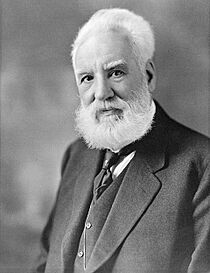
BU has been home to many Nobel Prize winners in science. Alexander Graham Bell did many of his experiments at BU. The university supported his research, which led to the invention of the telephone.
Other famous BU scientists include Sheldon Glashow and Daniel Tsui, who won Nobel Prizes in Physics. Osamu Shimomura won the Nobel Prize in Chemistry.
Writers and Authors
Two U.S. Poets Laureate, Robert Lowell and Robert Pinsky, have taught at BU. Nobel Prize-winning writers like Elie Wiesel and Saul Bellow also taught there. Another Nobel Prize winner, Derek Walcott, was in the English Department.
Many BU alumni have won Pulitzer Prizes. Other famous writers connected to BU include Ha Jin, Jhumpa Lahiri, and Isaac Asimov. Paul Beatty, who studied psychology at BU, won the Man Booker Prize for his novel The Sellout.
David Grann, a writer for The New Yorker, earned his master's degree from BU. His novel Killers of the Flower Moon was made into a movie.
Government and Political Figures
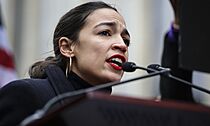
Boston University alumni include many governors, U.S. senators, and members of the U.S. House of Representatives.
BU graduates have achieved many historical firsts in U.S. history. Edward Brooke III was the first African-American Senator. Barbara Jordan was the first African-American Representative from a Southern state. Gary Locke was the first Chinese American governor. Alexandria Ocasio-Cortez is the youngest woman elected to the House.
Other notable alumni in politics include former Defense Secretary William Cohen and former Second Lady Tipper Gore. Former President William Howard Taft lectured at BU's law school.
In international politics, BU alumni include Sherwin Gatchalian, a Philippine senator, and Archbishop Makarios, the first President of Cyprus.
Film and Television Stars
Many Boston University graduates work in Hollywood. Over 5,000 alumni work in entertainment, and more than half are women. Graduates have won or been nominated for Academy Awards, Emmy Awards, and Golden Globes.
Harold Russell won BU's first Oscar in 1949 for The Best Years of Our Lives. Faye Dunaway won Best Actress for Network. Geena Davis won Best Supporting Actress for The Accidental Tourist. She also received a special humanitarian award from the Academy.
Julianne Moore won Best Actress for Still Alice. Alfre Woodard has won four Emmy Awards. Olympia Dukakis won Best Supporting Actress for Moonstruck.
Alumni Roy Conli and Peter Del Vecho won back-to-back Best Animated Feature for Frozen and Big Hero 6.
Media and Pop Culture Figures
Boston University graduates in media include radio personality Howard Stern and Bravo executive Andy Cohen. Other famous alumni include celebrity chef Rocco DiSpirito, self-help author Mark Manson, and This Old House presenter Kevin O'Connor.
Nina Garcia, editor-in-chief of Elle magazine, and comedian Marc Maron also graduated from BU.
Sports Figures
David Hemery, who won a gold medal in the 1968 Olympics, was a student and coach at BU. John Thomas won a silver medal in the Olympic High Jump.
Four BU alumni played on the 1980 U.S. Olympic gold medal-winning men's hockey team, known for the "Miracle on Ice". These players were Mike Eruzione, Jim Craig, Jack O'Callahan, and Dave Silk.
In July 2024, Macklin Celebrini was the first overall pick in the NHL draft. He is the second BU Terrier to be drafted first overall.
Travis Roy, a former BU ice hockey player, became quadriplegic after an injury in his first game. He later founded the Travis Roy Foundation to help others with spinal cord injuries.
Images for kids
See also
 In Spanish: Universidad de Boston para niños
In Spanish: Universidad de Boston para niños


